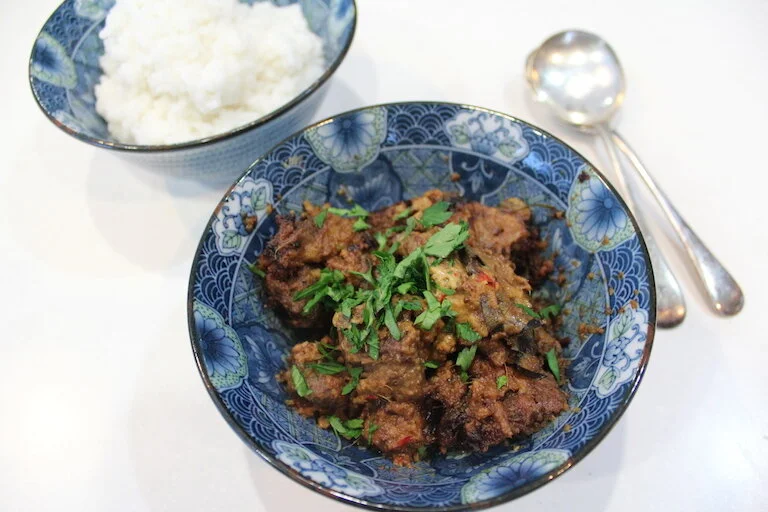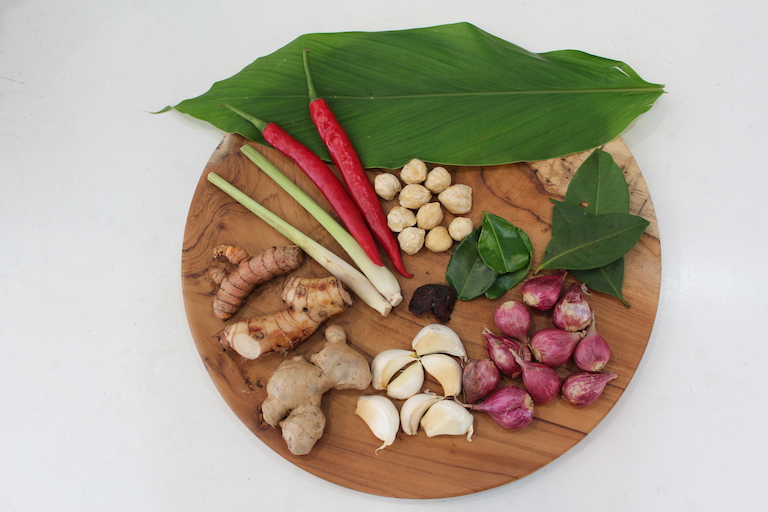How to Make this Rich and Spicy Beef Rendang
It is a long weekend in Jakarta; why not use this extra day to include a new local recipe in your repertoire? Beef Rendang! This is the perfect opportunity to visit your neighbourhood mobile grocer to buy fresh Indonesian spices which are the essence of authentic Rendang. Better still, bring the kids along with you to share in the experience. Together you can practise using your best Bahasa Indonesia and be a part of your neighbourhood food culture.
This original Rendang recipe is attributed to Ibu Mina, who is our Pembantu (family helper). One of the privileges of living in Indonesia is having home help. In our early Jakarta days, Ibu Mina shared with me where to buy fresh spices, and how to cook Beef Rendang. We did have one minor hiccup on my part prior to making Rendang. Ibu Mina asked me to purchase a mortar and pestle while I was out grocery shopping, which I learned was the most important utensil in Indonesian cooking. Mistakenly I purchased a mortar and pestle for grinding medicine, and it was not nearly big enough or appropriate for the task at hand. I had a lot to learn... and I am very grateful to Ibu Mina for continuing to teach me.
Ibu Mina has an excellent knowledge of where to source local spices. Her first choice is our local mobile green grocer who visits our street every day around 8am.
5 fast Rendang facts:
Now for 5 fast facts about Rendang and an introduction to the Indonesian mortar and pestle, the 'Hero Utensil' used to make Rendang.
Beef Rendang or Spicy beef in coconut, is one of many popular regional dishes enjoyed in Indonesia.
Beef Rendang originated in Padang, West Sumatra, and features chunks of beef slowly cooked in delicious coconut and fresh spices.
The traditional Indonesian mortar and pestle (cobek ulek ulek, pronounced cho-bek oolek oolek) is made from hard basalt stone and is a tool for extracting the flavour from fresh spices (bumbu).
The Indonesian cook rubs or grinds ingredients with a backwards and forward motion across the stone, which is broad and slightly rounded but almost flat. (also a great arm and wrist workout!)
The cobek ulek ulek is a visually handsome piece of kitchen equipment, but note it is heavy; so be sure to store yours on the 'kitchen bench' and not up high in that 'hard to reach' cupboard. The cobek ulek ulek can be purchased at your local pasar, some Jakarta kitchen shops and large supermarkets.
*This recipe is very rich due to the use of fresh spices.
Beef Rendang
Serves: 4
Cooking Time: 2 hours
Serve with steamed rice (nasi putih) and lime wedges (jeruk nipis)
Ingredients
1kg stewing beef
4 cups coconut milk
2 tblsp vegetable oil
1 turmeric leaf (daun kunyit)
2 stems lemon grass, thick bottom third only, outer layers discarded, stems bruised using the back of a knife (serai)
3 kaffir lime leaves (daun jeruk purut)
3 Indonesian bay leaves (daun salam)
1 tsp tamarind paste (asam kandis)
Spice paste (rempah)
7 cloves garlic, peeled (bawang putih)
10 shallots, peeled (bawang mereh)
1 knob of fresh ginger, peeled, sliced (jahe)
1 large galangal, peeled, sliced (laos)
1 knob of turmeric, peeled, sliced (kunyit)
2 large red chilli (cabe)
10 candlenuts (buah kemiri)
Method
1. Remove fat and sinew from beef, cut into 3 cm cubes, place in bowl.
2. Using a mortar and pestle grind the spices until aromatic and form a thick paste. Alternatively blend in a food processor. * See Cook's Notes point 1 below for instructions and order in which to grind the spices.
3. Heat the oil on high in a wok or heavy based pan and add the spice paste (rempah). Stir-fry the spice paste until fragrant.
4. Add kaffir lime, turmeric leaf, lemongrass, Indonesian bay leaf and tamarind paste to the pan with the spice paste.
5. Add the beef to the pan and brown. Stir in coconut milk and mix all ingredients together.
6. Bring to the boil, reduce heat to medium and simmer uncovered, for approximately 1 hour, stirring occasionally.
7. Reduce heat to very low, simmer for 1 hour, stirring frequently, or until the meat is very tender and the liquid has been absorbed.
* Cook's Notes:
Using a mortar and pestle start by grinding the garlic, shallots, ginger, galangal, turmeric, chilli and lastly the candlenut; using a back and forth motion, pushing down and pivoting the pestle as you go until it forms a thick paste.
Add additional coconut milk if you like more gravy with your Rendang, but traditionally Indonesian Rendang is a dry curry.
This dish tastes better if left to sit for several hours, or even overnight in the refrigerator, and enjoyed the next day.
Fresh spices (bumbu dapur) Clockwise: turmeric, galangal, lemongrass, chilli, candlenut, turmeric leaf, Indonesian bay leaf, kaffir lime, tamarind paste, shallots, garlic, ginger
The cobek ulek ulek (mortar and pestle) ready to be used to hand grind the bumbu (spice paste). Clockwise: kaffir lime, candlenut, shallots, garlic, ginger, turmeric, chilli and lemongrass
Silahkan makan! (An invitation to begin your meal)
Words: Liz McClean Photography: a journey bespoke








